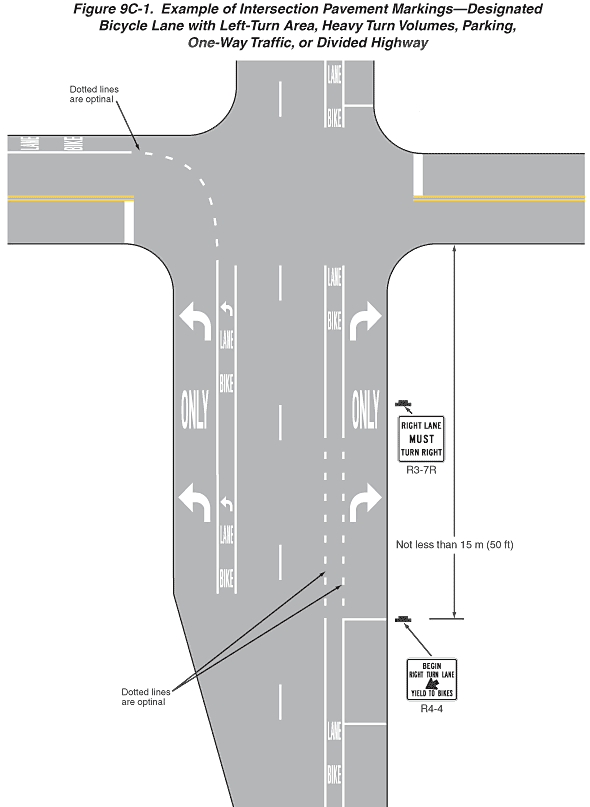
Figure 9C-1. Example of Intersection Pavement Markings—Designated Bicycle Lane with Left-Turn Area, Heavy Turn Volumes, Parking, One-Way Traffic, or Divided Highway
This figure illustrates an example of intersection pavement markings for a designated bicycle lane with a left-turn area, heavy turn volumes, parking, one-way traffic, or divided highway.
The figure shows a horizontal roadway intersecting a vertical roadway.
The horizontal roadway shows a solid double yellow line separating two lanes. A solid white stop line is shown marked on the pavement in the right lanes on both sides of the intersection. On the part of the roadway west of the intersection, the westbound portion of the roadway is shown divided into a regular lane and a far right lane marked with the words "BIKE LANE" in white on the pavement. West of the intersection, the bike lane is separated from the regular lane by a solid white line.
On the part of the vertical roadway south of the intersection, the two centermost (through) lanes are shown separated from each other by a broken white line. On the northbound approach to the intersection, the vertical roadway is shown as flaring out to add two additional lanes on the left side. These two added lanes are shown separated from each other and from the through lanes by a solid white line. The far left lane is shown with a white left-turn arrow in advance of the word "ONLY" in advance of a second left-turn arrow all marked in white on the pavement in that lane. The rightmost of the two added lanes is shown with the words "BIKE" and "LANE" in advance of a left-turn arrow all marked in white on the pavement in that lane. The solid white line that separates these two added lanes from each other is shown becoming a dotted white line within the intersection, and this dotted white line is shown curving 90 degrees to the left to connect with the solid white line on the westbound portion of the horizontal roadway west of the intersection. A note with an arrow pointing to the dotted line states "Dotted lines are optional."
Also on the northbound approach to the intersection, at the bottom of the figure, to the right of the centermost (through) lanes and shown separated from those lanes by a solid white line, a lane is shown with the word "BIKE" in advance of the word "LANE" marked in white on the pavement twice in advance of the intersection. To the right of that lane, two sequential rectangular boxes are shown marked on the pavement by solid white lines (symbolizing parking spaces). Closest to the intersection on the northbound approach, the lane farthest to the right is shown with a white right-turn arrow in advance of the word "ONLY" in advance of a second right-turn arrow all marked in white on the pavement, and this lane is shown separated from the "BIKE LANE" by a solid white line. At a point shown as a dimension of "not less than 15 m (50 ft)" from the intersection, the solid line separating the center lanes from the "BIKE LANE" is shown changing to a dotted white line at the northern end of the rectangular boxes and then is shown changing back to a solid white line closer to the intersection. A note with two arrows pointing to both dotted lines states "Dotted lines are optional." From the north end of the rectangular boxes symbolizing parking spaces, a dotted white line is shown separating the "BIKE LANE" from the rightmost lane on the northbound approach, and then that dotted white line is shown changing to a solid white line closer to the intersection. At the north end of the rectangular boxes symbolizing parking spaces, a sign is shown to the right of the roadway, facing northbound traffic. It is shown as an R4-4 sign with the words "BEGIN RIGHT TURN LANE" on two lines, a diagonal arrow pointing down and to the left, and the words "YIELD TO BIKES." Closer to the intersection, opposite the word "ONLY" marked on the pavement of the rightmost lane, another sign is shown placed to the right of the roadway, facing northbound traffic. It is shown as an R3-7R sign with the words "RIGHT LANE MUST TURN RIGHT" on three lines.
On the part of the vertical roadway north of the intersection, the two through lanes are shown separated by a broken white line. To the right of the through lanes and separated from the through lanes by a solid white line, a lane is shown with the word "BIKE" in advance of the word "LANE" marked in white on the pavement of the lane. To the right of the "BIKE LANE," a rectangular box is shown formed by solid white lines (symbolizing a parking space).
